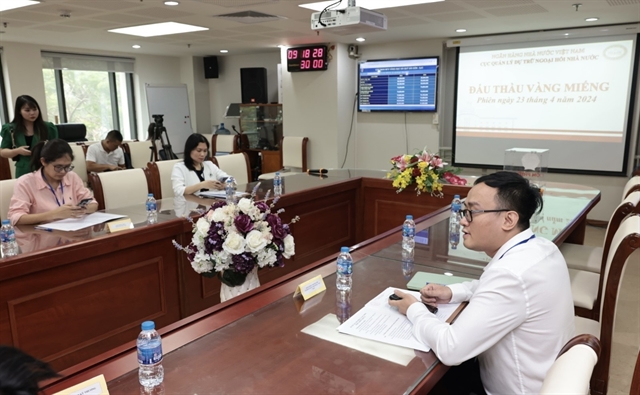

It has not been easy for farmers.
Now there are plans to farm with animals that do well in places that are dry.
These animals are sheep, bees, silkworms, ostriches and goats.
" />The central regions have been hit by drought.
It has not been easy for farmers.
Now there are plans to farm with animals that do well in places that are dry.
These animals are sheep, bees, silkworms, ostriches and goats.
 |
| The Tây Nguyên (Central Highlands) and central regions are expanding areas to breed livestock as well as other animals like sheep, ostriches, goats, honeybees and silkworms.– Photo nongnghiep.vn |
The central regions have been hit by drought.
It has not been easy for farmers.
Now there are plans to farm with animals that do well in places that are dry.
These animals are sheep, bees, silkworms, ostriches and goats.
KHÁNH HOÀ – The Tây Nguyên (Central Highlands) and central regions are expanding areas to breed livestock as well as other animals like sheep, ostriches, goats, honeybees and silkworms.
Hoàng Thanh Vân, head of the Animal Husbandry Department at the Ministry of Agriculture and Rural Development, said the central region accounted for the largest proportion of these kinds of animals.
Vân spoke at a seminar held in central Khánh Hoà Province about the effects of drought and saltwater intrusion on animal husbandry in the south-central coastal region.
MARD’s Deputy Minister Vũ Văn Tám, who also spoke at the seminar, has assigned the Animal Husbandry Department to assess the future of animal breeding during periods of prolonged heat waves and drought. The plan will also include new zones for animal husbandry.
Sheep output in the two central regions has reached 1,850 tonnes a year, accounting for more than 98 per cent of the country’s sheep output, according to MARD’s Animal Husbandry Department.
Most sheep in the region are bred in the coastal provinces of Ninh Thuận and Khánh Hoà.
The breeding of sheep, ostriches, goats, honeybees and silkworms have helped increase farmers’ income, especially after losses of crops affected by drought and saltwater intrusion.
The Central Highlands area produces 9.3 tonnes of honey a year, accounting for 60 per cent of the country’s honey output.
In recent years, drought and freshwater shortage have seriously affected animal breeding in the central region, especially in Khánh Hoà, Ninh Thuận and Đắk Lắk provinces.
Tào Anh Tuấn, deputy director of the Khánh Hoà Province Department of Agriculture and Rural Development, said the province’s animal quantity had not declined in recent years, but the impact of the ongoing drought had led to the death of many cattle in Cam Ranh City.
“The drought has also reduced the amount of natural food for animals,” he said.
In Khánh Hoà Province, officials are drafting a plan for its agricultural restructuring, with a focus on animal husbandry. It will give priority to develop animals that can survive drought conditions.
Both Khánh Hoà and the central region in general are facing a shortage of water as well as animal feed and drought-resistant breeding stock.
Hydro-meteorology forecasts have said that the south-central region will continue to be affected by severe drought, according to Nguyễn Văn Tỉnh, deputy head of MARD’s Irrigation Department.
A shortage of fresh water for daily use as well as animal food is expected to occur in several provinces like Ninh Thuận, Khánh Hoà, Phú Yên and Bình Định.
Drought in the south-central region is forecast to continue until the end of August. -VNS
GLOSSARY
The Tây Nguyên (Central Highlands) and central regions are expanding areas to breed livestock as well as other animals like sheep, ostriches, goats, honeybees and silkworms.
Livestock means farm animals, such as cows, buffalo, sheep, chickens, goats, horses, ducks and so on.
Vân spoke at a seminar held in central Khánh Hoà Province about the effects of drought and saltwater intrusion on animal husbandry in the south-central coastal region.
A seminar is a type of meeting.
Animal husbandry means the farming of animals.
MARD’s Deputy Minister Vũ Văn Tám, who also spoke at the seminar, has assigned the Animal Husbandry Department to assess the future of animal breeding during periods of prolonged heat waves and drought.
To assess the future of animal breeding means to study it and decide how it is doing.
A prolonged heat wave is one that goes on and on and on and seems to never end.
Sheep output in the two central regions has reached 1,850 tonnes a year, accounting for more than 98 per cent of the country’s sheep output, according to MARD’s Animal Husbandry Department.
Output means production.
The breeding of sheep, ostriches, goats, honeybees and silkworms have helped increase farmers’ income, especially after losses of crops affected by drought and saltwater intrusion.
Saltwater intrusion happens when saltwater slowly seeps into the soil.
Tào Anh Tuấn, deputy director of the Khánh Hoà Province Department of Agriculture and Rural Development, said the province’s animal quantity had not declined in recent years, but the impact of the ongoing drought had led to the death of many cattle in Cam Ranh City.
Animal quantity means the number of animals.
If animal quantity did not decline, it means that the number of animals did not go down.
In Khánh Hoà Province, officials are drafting a plan for its agricultural restructuring, with a focus on animal husbandry.
To draft a plan means to put together a plan of that plan but not the final plan.
To restructure means to organise a system of getting things done so that things are done differently to how they would have been done in the past.
It will give priority to develop animals that can survive drought conditions.
To give priority to something means to put it first on your list of things to be done.
Both Khánh Hoà and the central region in general are facing a shortage of water as well as animal feed and drought-resistant breeding stock.
Breeding stock is made up of animals that are kept especially for breeding purposes.
If an animal is drought-resistant it does not need as much water as many other animals need and therefore can survive dry conditions.
Hydro-meteorology forecasts have said that the south-central region would continue to be affected by severe drought, according to Nguyễn Văn Tỉnh, deputy head of MARD’s Irrigation Department.
Hydro-meteorology forecasts are weather forecasts that focus on water issues such as rain and humidity.
WORKSHEET
State whether the following sentences are true, or false:
1.True; 2. True; 3. False; 4. False; 5. True.









